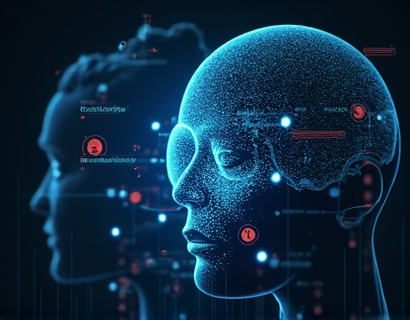Unlocking Transformative Digital Engagement: The Synergy of Crypto and AI
The intersection of cryptocurrency and artificial intelligence (AI) is giving rise to a new era of digital engagement, one that promises to revolutionize user interactions and drive unprecedented growth in the tech landscape. This article delves into the strategic insights and innovative approaches that tech-savvy professionals can leverage to enhance user experience and foster growth in this dynamic and rapidly evolving space.
The fusion of blockchain technology and AI is creating powerful tools that can significantly elevate digital engagement. By combining the transparency, security, and decentralization of crypto with the analytical prowess and adaptability of AI, businesses and developers can craft more intuitive, personalized, and secure user experiences. This synergy is not just a technological advancement but a paradigm shift in how we interact with digital platforms and services.
Understanding the Individual Powers of Crypto and AI
To fully appreciate the potential of their synergy, it's essential to first understand the individual capabilities of cryptocurrency and AI.
Cryptocurrency, at its core, is a digital or virtual currency that uses cryptography for security and operates on a decentralized network, typically a blockchain. This decentralized nature ensures that no single entity has control over the entire network, making transactions transparent, secure, and resistant to censorship. Cryptocurrencies like Bitcoin, Ethereum, and others have already transformed financial transactions, but their potential extends far beyond mere currency exchange.
AI, on the other hand, refers to the simulation of human intelligence processes by machines, particularly computer systems. These processes include learning (the acquisition of information and rules for using it), reasoning (using rules to reach approximate or definite conclusions), and self-correction. AI technologies such as machine learning, natural language processing, and computer vision are enabling machines to perform tasks that traditionally required human intervention, thereby enhancing efficiency and accuracy.
The combination of these two technologies creates a powerful toolkit for innovation. Crypto provides a secure and decentralized infrastructure, while AI brings intelligent and adaptive capabilities. Together, they can create systems that are not only secure and transparent but also highly responsive and personalized to user needs.
Enhancing User Interaction Through Crypto and AI
The synergy of crypto and AI can significantly enhance user interaction in several ways, making digital experiences more engaging, secure, and personalized.
Firstly, security and trust are paramount in digital interactions. Crypto's inherent security features, such as encryption and decentralization, ensure that user data and transactions are protected from unauthorized access and tampering. When combined with AI's ability to detect and prevent fraudulent activities through advanced analytics and machine learning, the result is a highly secure environment that builds user trust. For instance, AI-driven systems can monitor transaction patterns in real-time, identifying anomalies and potential threats before they become issues.
Secondly, personalization is a key driver of user engagement. AI algorithms can analyze vast amounts of user data to understand preferences, behaviors, and needs, allowing for highly tailored experiences. In the context of crypto, this means creating personalized wallet interfaces, customized investment recommendations, and targeted content delivery. For example, an AI-powered platform can suggest crypto assets based on a user's investment history and risk tolerance, enhancing the overall user experience and satisfaction.
Thirdly, decentralized applications (dApps) powered by blockchain and AI can offer new levels of interactivity and autonomy. dApps can leverage AI to provide intelligent services without relying on centralized servers, reducing latency and increasing reliability. Users can interact with these applications in a more direct and control-oriented manner, knowing that their data and transactions are secure and transparent. This decentralized approach also opens up new possibilities for community-driven development and governance, further enhancing user engagement.
Driving Growth Through Strategic Integration
To harness the full potential of crypto and AI synergy, businesses and developers must adopt strategic approaches that focus on innovation, user-centric design, and scalable solutions.
Innovation is the cornerstone of success in this space. Tech-savvy professionals should explore cutting-edge technologies and methodologies that can be integrated into their projects. For instance, leveraging blockchain's smart contracts in conjunction with AI's predictive analytics can create automated and intelligent systems that adapt to user needs and market conditions in real-time. This fusion can lead to the development of novel services and applications that offer unique value propositions.
User-centric design is crucial for creating engaging and effective digital experiences. Understanding the end-user's journey and pain points is essential. AI can play a significant role here by providing insights through data analysis, helping designers and developers create interfaces that are intuitive and user-friendly. Additionally, AI-driven chatbots and virtual assistants can enhance user support, providing instant and personalized assistance, thereby improving user satisfaction and retention.
Scalability is another critical factor. As the crypto and AI landscape grows, solutions must be able to handle increasing amounts of data and user interactions without compromising performance. Blockchain technologies like sharding and layer 2 solutions, combined with AI's ability to optimize resource allocation and manage complex workflows, can ensure that systems remain efficient and responsive even as they scale.
Case Studies and Real-World Applications
Several projects and platforms are already demonstrating the power of crypto and AI synergy in enhancing digital engagement.
One notable example is Decentralized Finance (DeFi) platforms that integrate AI for risk management and portfolio optimization. These platforms use AI algorithms to analyze market data, predict price movements, and suggest optimal trading strategies. By combining this with the transparency and security of blockchain, users can make informed decisions with enhanced trust and security.
Another example is NFT (Non-Fungible Token) marketplaces that leverage AI for content recommendation and authentication. AI can analyze user preferences and suggest NFTs that align with their interests, while blockchain ensures the authenticity and ownership of these digital assets. This combination not only enhances user engagement but also opens up new revenue streams for creators and collectors.
Social media platforms powered by crypto and AI are also redefining user interactions. These platforms use AI to curate personalized feeds and ensure content authenticity through blockchain-based verification. Users benefit from a more relevant and trustworthy experience, while the decentralized nature of the platform reduces the risk of censorship and data breaches.
Challenges and Considerations
While the potential of crypto and AI synergy is immense, there are several challenges and considerations that must be addressed to ensure successful implementation.
Regulatory compliance is a significant concern. The crypto space is still navigating a complex regulatory landscape, and AI systems must adhere to data protection and privacy laws. Developers and businesses must stay informed about regulatory changes and ensure their solutions comply with relevant regulations to avoid legal issues and maintain user trust.
Technical complexity is another challenge. Integrating blockchain and AI requires a high level of technical expertise and resources. Teams need to have a deep understanding of both technologies and how they can be effectively combined. Collaboration with experts in both fields can help overcome these challenges and drive successful projects.
User education is crucial for widespread adoption. Many users are still unfamiliar with crypto and AI concepts, which can hinder the adoption of new technologies. Providing educational resources, tutorials, and user-friendly interfaces can help bridge this knowledge gap and encourage more users to engage with these innovative solutions.
Conclusion
The synergy of cryptocurrency and artificial intelligence is poised to transform digital engagement, offering unprecedented opportunities for innovation, security, and personalization. By understanding the individual strengths of both technologies and strategically integrating them, tech-savvy professionals can create next-generation user experiences that drive growth and efficiency in the dynamic crypto and AI landscape. As the field continues to evolve, staying informed, adaptable, and user-focused will be key to unlocking the full potential of this exciting synergy.









































